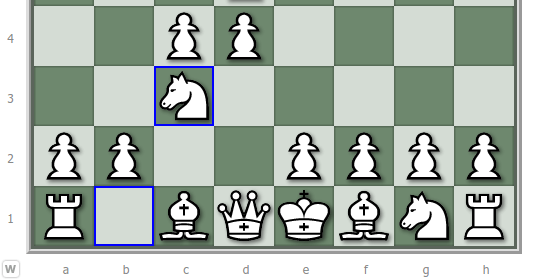
In searching for the best starting moves in chess, White is confronted with twenty possible first moves. White may move any one of his eight pawns one or two spaces forward. White may also move either of his knights onto the third row, to a3, c3, f3 or h3.
Of those twenty possibilities, the best starting moves in chess are those that attack the centre or help development. So forget about starting with your flanking pawns.
Also, do not start by moving one of your knights to the edge of the board.
e4 and d4: The Two Best Starting Moves in Chess
There are two options that most people agree are the best starting moves in chess. They are 1.e4 and 1.d4. That is, White begins by moving either the king’s pawn or the queen’s pawn two spaces forward. In either case, white is attacking the centre and preparing to develop his pieces.
The starting moves, 1.e4 and 1.d4 dominate opening theory. The Penguin Book of Chess Openings devotes 209 of the 252 pages of the book to those starting moves.
Why 1.d4… 2c4 Are The Best Starting Moves In Chess For White
I suggest that you choose ONE of those two starting moves and study it in more detail from White’s perspective. The starting move I recommend is 1.d4 and that is how I open most of my games as White. It is generally felt that 1.d4 is a steadier opening than 1.e4:
In general the Queen’s Pawn openings are quieter in the early stages, with the emphasis on securing favourable pawn structures and gaining space.
W. R. Hartston, The Penguin Book of Chess Openings, p. 161
Another benefit of starting with 1.d4 is that you can usually follow up with 2.c4 and often with 3.Nc3. Those are what I consider the best starting moves in chess when playing as White. Those starting moves are well established as a sound opening for White. They will set you up with a solid claim on the centre of the board and a great deal of flexibility in dealing with various responses from Black.
The Advantages Of Working With One Opening Sequence
Also, by choosing ONE opening sequence as White, you can concentrate your efforts when you study chess. If you are like most amateur chess players, you only have a limited amount of time to study chess. As White, you have the luxury of moving first. You can choose which piece to move, whereas Black has to respond to what you do.
As time is limited, it is more efficient to focus on building competence in ONE opening as White. That is especially so when you are a beginner or elementary player. It is easy to get confused by the mass of opening theory and never achieve competence in any opening.
Of course, you will need to study how to respond as Black to White’s various openings, but that is another story.
In recommending this opening sequence I have been influenced by the teaching of International Master, John Watson. His book, A Strategic Chess Opening Repertoire for White offers a complete plan of attack with 1.d4 and 2.c4.

Exceptions: When d4, c4, Nc3 Are NOT The Best Starting Moves In Chess For White
In his book, John Watson recommends 1.d4… 2.c4 in almost every scenario except some unusual black responses such as the Saint George defence (1. d4 b4 2.e4…) and some versions of the Benoni where black responds 1…. c5:
-
- d4 c5
- d5
The third move, Nc3 occurs in the majority of openings with this repertoire. Notable exceptions are the third move in the Queen’s Gambit Accepted and mainline Benoni systems:
Queen’s Gambit Accepted
-
- d4 d5
-
- c4 dxc4
- Nf3
3.Nf3 protects White from 3. … e5.
Benoni
-
- d4 Nf6
-
- c4 c5
- d5
In most cases, however, I suggest the best starting moves in chess for white, if you want to keep things easy for yourself, are 1.d4… 2.c4 and 3.Nc3.
David Hurley
EasyChessTips.com